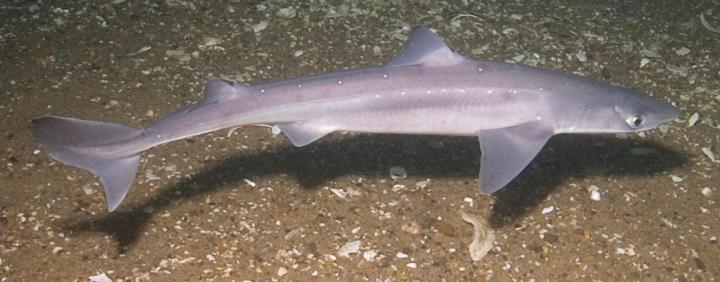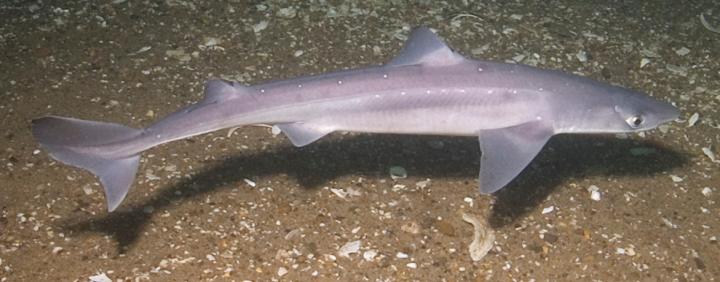
Credit: Doug Costa, NOAA/SBNMS
WASHINGTON — A synthesized steroid mirroring one naturally made by the dogfish shark prevents the buildup of a lethal protein implicated in some neurodegenerative diseases, reports an international research team studying an animal model of Parkinson's disease. The clustering of this protein, alpha-synuclein (α-synuclein), is the hallmark of Parkinson's and dementia with Lewy bodies, suggesting a new potential compound for therapeutic research.
The finding, published online in Proceedings of the National Academy of Sciences, also demonstrated that the synthesized steroid, called squalamine, reduced the toxicity of α-synuclein clumps that already existed.
The pre-clinical study results show that squalamine prevents and eliminates α-synuclein build up inside neurons by unsticking the protein from the inner wall of nerve cells, where it clings and builds up into toxic clumps, researchers say.
The animal model used for this study, C. elegans, is a nematode worm genetically engineered to produce human α-synuclein in its muscles. As these worms age, α-synuclein builds up within their muscle cells causing cell damage and paralysis.
"We could literally see that squalamine, given orally to the worms, did not allow α-synuclein to cluster, and prevented muscular paralysis inside the worms," says the study's co-senior author, Michael Zasloff, MD, PhD, professor of surgery and pediatrics at Georgetown University School of Medicine and scientific director of the MedStar Georgetown Transplant Institute.
The study's lead author, graduate student Michele Perni, and other co-senior authors, Michele Vendruscolo, PhD and Christopher M. Dobson, DPhil, ScD, are from Cambridge University. An additional co-senior author, Adriaan Bax, PhD, is from National Institute of Diabetes and Digestive and Kidney Diseases (NIDDK), part of the National Institutes of Health (NIH) in Bethesda, Maryland. Scientists from the Netherlands, Italy and Spain also contributed to this research.
Zasloff, an expert in innate immune systems, has been studying squalamine for more than 20 years. He discovered it in dogfish sharks in 1993 and synthesized it in 1995 (in a process that does not involve use of any natural shark tissue). His research, as well as that by other scientists, has established antiviral and anticancer properties of the compound. This is the first study to show it has neurological benefits in in vivo models of Parkinson's.
In Parkinson's disease, α-synuclein, a normal protein present within the nervous system, forms toxic clumps that damage and ultimately destroy the neurons in which they form. Considerable research has been directed at discovering compounds that prevent the formation of these masses, thereby representing potential therapeutics for Parkinson's disease.
In this study, the researchers demonstrated in a series of in vitro experiments that squalamine, a positively charged molecule with a high affinity for negatively charged membranes, could literally "kick off" α-synuclein from negatively charged membranes, where the protein binds, preventing the formation of the toxic clumps.
The research team also showed that squalamine could protect healthy human neuronal cells from being damaged by exposure to pre-formed toxic masses of α-synuclein, by preventing them from adhering to the outer membrane of the neuronal cells.
The researchers then extended these studies to a living system, C. elegans, a well-studied model of Parkinson's disease. "Orally administered squalamine prevented the formation of toxic α-synuclein clumps in this complex animal, and rescued the animal from loss of mobility," Zasloff explains. "This experiment taught us that the basic mechanism demonstrated in vitro achieved the anticipated outcome in an animal."
###
The study's co-senior author, Professor Christopher Dobson, DPhil, Master of St John's College, University of Cambridge says, "Squalamine gives us a first generation compound, which we believe that we can incrementally improve through further studies of the underlying mechanism by which it affects the aggregation of alpha-synuclein."
Zasloff says a clinical trial with squalamine in Parkinson's disease is being planned. "Squalamine could be especially suited to work in the gut with the goal of treating the gastrointestinal symptoms of Parkinson's," he adds.
Zasloff is the inventor on a patent application that has been filed related to the technology described in this paper. The other authors report having no personal financial interests related to the study.
Additional authors include Celine Galvagnion, Georg Meisl, Martin B. D. Müller, Pavan K. Challa, Patrick Flagmeier, Samuel I. A. Cohen, Pietro Sormanni, Gabriella T. Heller, Francesco A. Aprile, Tuomas P. J. Knowles, Michele Vendruscolo, Serene W. Chen, Ryan Limbocker and Julius Kirkegaard from the University of Cambridge, England; Alexander S. Maltsev, from NIDDK; Ellen A. Nollen, from the European Research Institute for the Biology of Aging, Groningen, The Netherlands; Roberta Cascella, Cristina Cecchi, and Fabrizio Chiti, from the University of Florence; and Nunilo Cremades, from the University of Zaragoza, Spain.
The study was funded by the NIH Intramural Research Program, the Boehringer Ingelheim Fonds, the European Research Council (ERC), and the Centre for Misfolding Diseases at Cambridge.
About Georgetown University Medical Center
Georgetown University Medical Center (GUMC) is an internationally recognized academic medical center with a three-part mission of research, teaching and patient care (through MedStar Health). GUMC's mission is carried out with a strong emphasis on public service and a dedication to the Catholic, Jesuit principle of cura personalis — or "care of the whole person." The Medical Center includes the School of Medicine and the School of Nursing & Health Studies, both nationally ranked; Georgetown Lombardi Comprehensive Cancer Center, designated as a comprehensive cancer center by the National Cancer Institute; and the Biomedical Graduate Research Organization, which accounts for the majority of externally funded research at GUMC including a Clinical and Translational Science Award from the National Institutes of Health. Connect with GUMC on Facebook (Facebook.com/GUMCUpdate), Twitter (@gumedcenter) and Instagram (@gumedcenter).
Media Contact
Karen Teber
[email protected]
@Gumedcenter
############
Story Source: Materials provided by Scienmag





